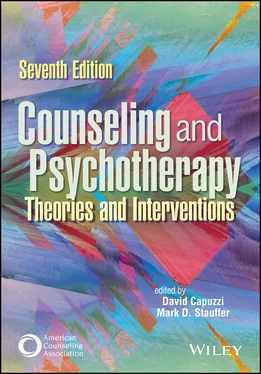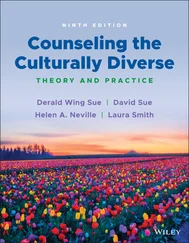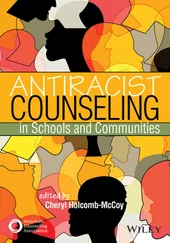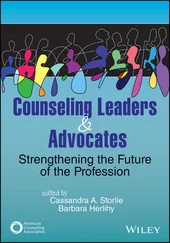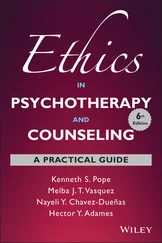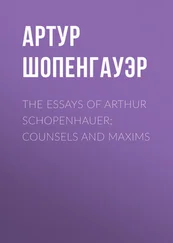Counseling and Psychotherapy
Здесь есть возможность читать онлайн «Counseling and Psychotherapy» — ознакомительный отрывок электронной книги совершенно бесплатно, а после прочтения отрывка купить полную версию. В некоторых случаях можно слушать аудио, скачать через торрент в формате fb2 и присутствует краткое содержание. Жанр: unrecognised, на английском языке. Описание произведения, (предисловие) а так же отзывы посетителей доступны на портале библиотеки ЛибКат.
- Название:Counseling and Psychotherapy
- Автор:
- Жанр:
- Год:неизвестен
- ISBN:нет данных
- Рейтинг книги:4 / 5. Голосов: 1
-
Избранное:Добавить в избранное
- Отзывы:
-
Ваша оценка:
- 80
- 1
- 2
- 3
- 4
- 5
Counseling and Psychotherapy: краткое содержание, описание и аннотация
Предлагаем к чтению аннотацию, описание, краткое содержание или предисловие (зависит от того, что написал сам автор книги «Counseling and Psychotherapy»). Если вы не нашли необходимую информацию о книге — напишите в комментариях, мы постараемся отыскать её.
Counseling and Psychotherapy — читать онлайн ознакомительный отрывок
Ниже представлен текст книги, разбитый по страницам. Система сохранения места последней прочитанной страницы, позволяет с удобством читать онлайн бесплатно книгу «Counseling and Psychotherapy», без необходимости каждый раз заново искать на чём Вы остановились. Поставьте закладку, и сможете в любой момент перейти на страницу, на которой закончили чтение.
Интервал:
Закладка:
24 Hartling, L., Lindner, E., Duffey, T., & Haberstroh, S. (2020). Raising our resilience in times of risk. In T. Duffey & S. Haberstroh (Eds.), Introduction to crisis and trauma counseling (pp. 313–328). American Counseling Association.
25 Haskins, N., & Appling, B. (2017). Relational‐cultural theory and reality therapy: A culturally responsive integrative framework. Journal of Counseling & Development, 95(1), 87–99. https://doi.org/10.1002/jcad.12120
26 Hill Collins, P. (2000). Black feminist thought: Knowledge, consciousness, and the politics of empowerment (2nd ed.). Routledge.
27 Hitter, T., Adams, E., & Cahill, E. (2017). Positive sexual self-schemas of women survivors of childhood sexual abuse. The Counseling Psychologist, 45(2), 266–293. https://doi.org/10.1177/0011000017697194
28 Hook, J., Farrell, J., Davis, D., DeBlaere, C., Van Tongeren, D., & Utsey, S. (2016). Cultural humility and racial microaggressions in counseling. Journal of Counseling Psychology, 63(3), 269–277. https://doi.org/10.1037/cou0000114
29 Jordan, J. V. (1991). The movement of mutuality and power (Work in Progress Series, No. 53). Wellesley College, Stone Center for Developmental Services and Studies.
30 Jordan, J. V. (2018). Relational-cultural therapy. American Psychological Association.
31 Jordan, J. V., & Duffey, T. (2020). The counseling relationship. In T. Duffey & S. Haberstroh (Eds.), Introduction to crisis and trauma counseling (pp. 45–70). American Counseling Association
32 Jordan, J. V., & Hartling, L. (2008). The development of relational-cultural theory (Work in Progress Series, No. 53). Wellesley College, Stone Center for Developmental Services and Studies.
33 Kress, V. E., Haiyasoso, M., Zoldan, C. A., Headley, J. A., & Trepal, H. (2018). The use of relational‐cultural theory in counseling clients who have traumatic stress disorders. Journal of Counseling & Development, 96(1), 106–114. https://doi.org/10.1002/jcad.12182
34 Lenz, A. (2016). Relational-cultural theory: Fostering the growth of a paradigm through empirical research. Journal of Counseling & Development, 94(4), 415–428. https://doi.org/10.1002/jcad.12100
35 Lenz, A., Holman, R., Lancaster, C., & Gotay, S. (2016). Effects of relational authenticity on adjustment to college. Journal of College Counseling, 19(1), 2–16. https://doi.org/10.1002/jocc.12027
36 Liang, B., Tracy, A., Taylor, C. A., Williams, L. M., Jordan, J. V.,& Miller, J. B. (2002). The Relational Health Indices: A study of women’s relationships. Psychology of Women Quarterly, 26, 25–35. https://doi.org/10.1111/1471-6402.00040
37 Miller, J. B. (1976). Toward a new psychology of women. Beacon Press.
38 Miller, J. B. (1986). Toward a new psychology of women (2nd ed.). Beacon Press.
39 Miller, J. B., & Stiver, I. P. (1995). Relational images and their meanings in psychotherapy (Work in Progress Series, No. 74). Wellesley College, Stone Center for Developmental Services and Studies.
40 Oakley, M., Addison, S., Piran, N., Johnston, G., Damianakis, M., Curry, J., Dunbar, C., & Weigeldt, A. (2013). Outcome study of brief relational-cultural therapy in a women’s mental health center. Psychotherapy Research, 23(2), 137–151. https://doi.org/10.1080/10503307.2012.745956
41 Peters, H., & Luke, M. (2021). Social justice in counseling: Moving to a multiplistic approach. Journal of Counselor Leadership and Advocacy, 8(1), 1–15. https://doi.org/10.1080/2326716X.2020.1854133
42 Purgason, L., Avent, J., Cashwell, C., Jordan, M., & Reese, R. (2016). Culturally relevant advising: Applying relational-cultural theory in counselor education. Journal of Counseling & Development, 94(4), 429–436. https://doi.org/10.1002/jcad.12101
43 Remley, T., & Herlihy, B. P. (2019). Ethical, legal, and professional issues in counseling (6th ed.). Pearson Education UK.
44 Singh, A. A., Appling, B., & Trepal, H. (2020). Using the multicultural and social justice counseling competencies to decolonize counseling practice: The important roles of theory, power, and action. Journal of Counseling & Development, 98(3), 261–271. https://doi.org/10.1002/jcad.12321
45 Singh, A. A., & Moss, L. (2016). Using relational-cultural theory in LGBTQQ counseling: Addressing heterosexism and enhancing relational competencies. Journal of Counseling & Development, 94(4), 398–404. https://doi.org/10.1002/jcad.12098
46 Stargell, N., Craigen, L., Bradley, N., Whisenhunt, J., Campbell, E., & Kress, V. E. (2020). Relational‐cultural supervision: A humanistic approach to promoting vulnerability and counselor development. The Journal of Humanistic Counseling, 59(3), 188–200. https://doi.org/10.1002/johc.12144
47 Storlie, C. A., Albritton, K., & Cureton, J. L. (2017). Familial and social influences in career exploration for female youth of color. The Family Journal, 25(4), 351–358. https://doi.org/10.1177/1066480717732142
48 Tantillo, M., & Sanftner, J. L. (2010). Measuring perceived mutuality in women with eating disorders: The development of the Connection-Disconnection Scale. Journal of Nursing Measurement, 18(2), 100–119. https://doi.org/10.1891/1061-3749.18.2.100
49 Trepal, H., & Duffey, T. (2016). Everything has changed: An interview with Judy Jordan. Journal of Counseling & Development, 94(4), 437–441. https://doi.org/10.1002/jcad.12102
50 Tuttle, M., & Haskins, N. (2017). “A different way”: The experiences of Latinx parents with school counselors. Journal for Social Action in Counseling and Psychology, 9(2), 95–111. https://doi.org/10.33043/JSACP.9.2.95-111
51 van der Kolk, B. (2014). The body keeps the score: Brain, mind, and body in the healing of trauma. Viking.
52 Vandermause, R., Roberts, M., & Odom-Maryon, T. (2018). Relational health in transitions: Female adolescents in chemical dependency treatment. Substance Use & Misuse, 53(8), 1353–1360. https://doi.org/10.1080/10826084.2017.1408655
53 Wampold, B. E. (2015). How important are the common factors in psychotherapy? An update. World Psychiatry, 14(3), 270–277. https://doi.org/10.1002/wps.20238
Chapter 3
Psychodynamic Theories: Psychoanalysis and Beyond
Adrianne L. Johnson and Anthony Zazzarino
The concepts of psychoanalysis have become interwoven into the fabric of U.S. culture, with terms such as Freudian slip, repression, and denial appearing regularly in everyday language. These concepts originated with the examination of unconscious pain, which manifests into maladaptive behaviors in psychoanalysis. Psychoanalytic theory suggests that early life experiences shape one’s social interactions and relationships in adulthood and is based on the concept that individuals are unaware of the many factors, including childhood trauma, that contribute to their maladaptive behaviors and discomforting emotions.
To accommodate contemporary mental health practices, and to meet the unique needs of diverse client populations, traditional psychoanalytic techniques have evolved into a dynamic inclusion of other theories, which increases its efficacy in fostering client self-awareness through modified application of classical techniques. This evolution has birthed other rapidly emerging approaches, including psychodynamic interpersonal therapy, transactional analysis, object relations theory, and brief psychodynamic theory. These distinctive theoretical approaches utilize original psychoanalytic concepts such as unconscious thoughts, instinctual drives, and psychological defenses formed early in life, but each approach features specific techniques that distinguish each in their application toward problem resolution.
The aim of this chapter is to help counselors gain a brief understanding of classical psychoanalytic theory and its influence on current practices and applications in contemporary mental health treatment. The goals of this chapter are to help counselors meet the following objectives: (a) gain a basic understanding of the foundation, history, and development of psychoanalytic theory; (b) gain a basic understanding of the implications of psychoanalytic theory across populations and contexts; and (c) gain a basic understanding of how to apply psychoanalytic and psychodynamic techniques in counseling practice for the most effective therapeutic outcomes.
Читать дальшеИнтервал:
Закладка:
Похожие книги на «Counseling and Psychotherapy»
Представляем Вашему вниманию похожие книги на «Counseling and Psychotherapy» списком для выбора. Мы отобрали схожую по названию и смыслу литературу в надежде предоставить читателям больше вариантов отыскать новые, интересные, ещё непрочитанные произведения.
Обсуждение, отзывы о книге «Counseling and Psychotherapy» и просто собственные мнения читателей. Оставьте ваши комментарии, напишите, что Вы думаете о произведении, его смысле или главных героях. Укажите что конкретно понравилось, а что нет, и почему Вы так считаете.
